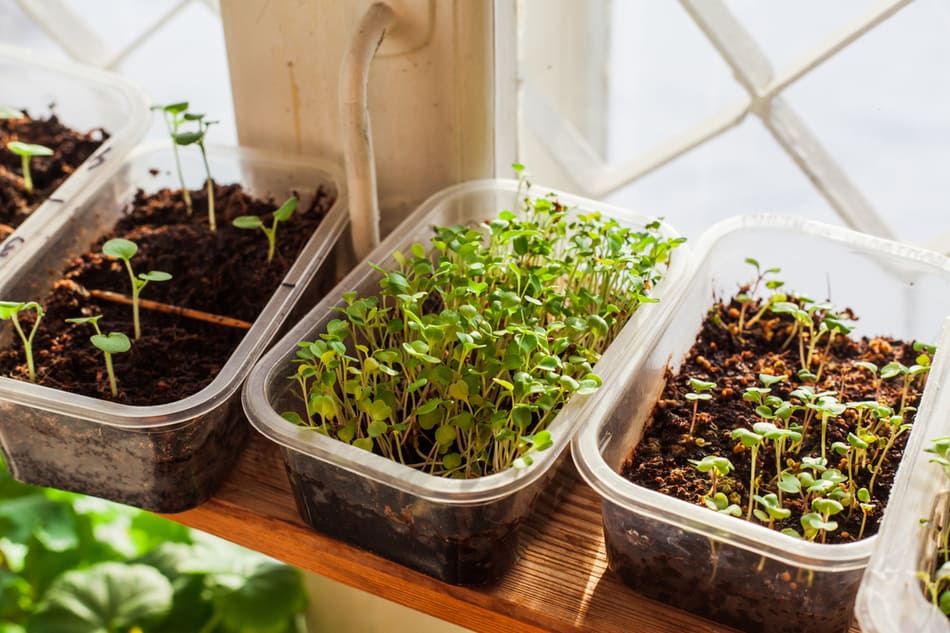Microgreens are a delicious, healthy addition to any meal, but sometimes you might find yourself with more than you can eat. Can microgreens be frozen? The answer is yes! In this guide, I will walk you through the process of freezing microgreens so that you can enjoy them all year long.
So can microgreens be frozen? Yes, you can, but freezing microgreens change their flavor, texture and color. Freezing also cracks cell walls, reducing certain nutrients or boosting others depending on how it’s done; for example, boiling takes away more vitamin C than drying does!
Microgreens have a limited life span if they are not refrigerated once thawed. If you don’t plan on using your microgreens right away or need them for an upcoming dish, it’s best to try and freeze a few at a time rather than letting all of these precious tiny plants turn slimy.

Which Microgreens Are The Best To Freeze?
While microgreens are typically grown for fresh consumption, some varieties can also be frozen for future use. When choosing which microgreens to freeze, it is essential to select greens with high water content. This will help ensure that they retain their color and flavor when thawed.
Freezing your microgreens may be one way to keep them fresh for longer periods. I would advise eating more if you have too many! Store properly in the fridge, and they’ll last up to two weeks, but there’s a type of plant that can benefit from freezing: Broccoli Microgreens & Sprouts!!
Freezing these veggies damages their cell walls, creating elevated levels of isothiocyanate sulforaphane when reactivated after drying out again–when we thaw them out upon returning home from grocery day.
What Happens When You Freeze Microgreens?
When you freeze microgreens, they will go through a process known as cryopreservation. This is where the greens are exposed to freezing temperatures, typically -196°C, to preserve them. During this process, the water inside the cells of the plants will turn into ice crystals.
These crystals will then damage the cell walls and membranes, leading to cell death. However, if the freezing is done correctly, the plants will retain their nutritional value and flavor. In order to ensure that your microgreens are properly frozen, it is important to use a food-grade freezer and to follow the instructions of your chosen method carefully. Once frozen, microgreens can be stored for up to six months.
How Do You Grow Microgreens?
While fresh microgreens are always the best option, sometimes you might find yourself with more than you can use. In these cases, freezing is a great way to preserve your microgreens and extend their shelf life.
First, start by washing the microgreens thoroughly with cool water. Next, spin or pat them dry. Then, place the greens in a freezer-safe container, making sure not to pack them too tightly. Label the container with the date and type of greens, then pop it in the freezer.

Frozen microgreens will retain their flavor and nutrition for up to six months. When you’re ready to use them, remove the container from the freezer and thaw the greens in the fridge overnight. Rinse them under cool water before using microgreens.
How Do You Prepare Them For Storage?
Most vegetables can be stored in a cool, dark place for up to a week, but a few need special attention. Here are some tips for storing your vegetables so they stay fresh and tasty:
- Potatoes should be stored in a cool, dark place with good ventilation. Do not wash them before storing, as this will shorten their shelf life. If you need to wash them, do so just before using them.
- Store tomatoes on the counter at your room temperature. Do not refrigerate them, as this will cause them to lose their flavor. If they start to soften, you can store them in the fridge for a day or two to prolong their life.
- Store garlic and shallots in a cool, dark place with good ventilation. Do not wash them before storing, as this will shorten their shelf life. If you need to wash them, do so just before using them.
- Store green beans in the fridge in a plastic bag or container. Do not wash them before storing, as this will shorten their shelf life. If you need to wash them, do so just before using them.
- Store carrots in the fridge in a plastic bag or container. Do not wash them before storing, as this will.
How To Dehydrate Microgreens
Microgreens are greens that are harvested when they are young, typically when they are about 2-3 inches tall. They are packed with nutrients and have a concentrated flavor that makes them a popular ingredient in salads, sandwiches and other dishes. Microgreens can be grown year-round, but they peak in the spring and summer. If you have an abundance of microgreens, you may want to dehydrate them to enjoy them throughout the year.
The first step in dehydrating microgreens is to wash them thoroughly. If you are using store-bought microgreens, they may already be pre-washed. However, it is always a good idea to give them a rinse before dehydrating. Next, spread the microgreens out on a dehydrator tray and set the temperature to 95 degrees Fahrenheit.
Dehydrate for 4-6 hours, or until the microgreens are completely dry. Once dehydrated, microgreens can be stored in an container for up to 6 months. To dehydrate, simply soak in water for 5 minutes before using. Dehydrated microgreens can be used in any dish that you would use fresh microgreens. Sprinkle them
So there you have it! Now you know everything there is to know about freezing microgreens.
Final Thoughts
Growing your own microgreens at home will often give you a harvest more significant than what can be eaten, so it is vital to know how best to store them. The tips and tricks shared in this article should last longer without going bad before being used or throwing away any excess produce!
Related Articles
How To Grow Microgreens Hydroponically
What Are The Healthiest Microgreens?
Can You Juice Microgreens?

